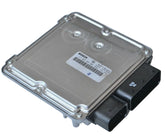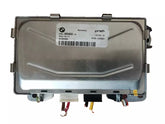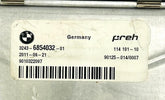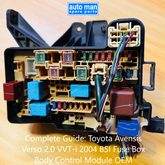وحدة التحكم في ناقل الحركة (TCU) هي حاسوب صغير يُوجِّه عمليات تغيير السرعات التلقائية. يقرأ هذا الحاسوب الحساسات ويُحدِّد ناقل الحركة عند تغيير السرعات لضمان قيادة سلسة وكفاءة عالية.
TL؛DR / النقاط الرئيسية
-
تعمل وحدة التحكم في ناقل الحركة (TCU/TCM) على إدارة عمليات تغيير التروس التلقائية باستخدام بيانات المحرك والمركبة.
-
تشمل العلامات النموذجية لوجود مشكلة في وحدة التحكم في ناقل الحركة (TCU) التأخير في التحولات، والتغيير القاسي، والانزلاق، ووضع الطوارئ، وأضواء التحذير.
-
تستخدم معظم المتاجر ماسح OBD-II وعمليات فحص البيانات المباشرة لتشخيص أعطال وحدة التحكم في ناقل الحركة (TCU)؛ وتُستخدم هذه الطريقة في أكثر من 80% من متاجر الإصلاح في الولايات المتحدة.
-
تبلغ تكلفة استبدال وحدة التحكم في ناقل الحركة في الولايات المتحدة عادةً ما بين 400 إلى 1200 دولار أمريكي؛ وقد يؤدي تجاهل المشكلات إلى زيادة إجمالي تكاليف النقل بنسبة 30% أو أكثر.
-
يمكنك إجراء التشخيص الأساسي في المنزل، ولكن العديد من الإصلاحات تتطلب إعادة البرمجة أو الاستبدال بشكل احترافي.
1) ما هي وحدة التحكم في ناقل الحركة (TCU/TCM) وكيف تؤثر على عملية التحول لديك؟
وحدة التحكم في ناقل الحركة (TCU) هي عقل ناقل الحركة، وتتحكم مباشرةً في تغيير التروس. تعالج الوحدة المدخلات من وحدة التحكم في المحرك، ومستشعرات السرعة، ومستشعرات الضغط، لضبط وقت تغيير التروس.
التعريف: وحدة التحكم في ناقل الحركة (TCU/TCM) هي الحاسوب الموجود على متن السيارة الذي يتحكم في عملية النقل التلقائي للسرعات. تعمل على تحسين توقيت النقل لتحسين الأداء وتوفير الوقود.
كيفية تفاعلها: تتبادل وحدة التحكم بالنقل البيانات مع وحدة التحكم الإلكترونية، وملفات ناقل الحركة، وحزمة توصيل السيارة. مثال: قد يؤدي خلل في تغذية مستشعر السرعة إلى إرباك وحدة التحكم بالنقل، مما يؤدي إلى تغيير مفاجئ في تروس السرعة.
لماذا يُؤثر عطل وحدة التحكم في ناقل الحركة (TCU) على قابلية القيادة: قد يُسبب خلل في المنطق أو المدخلات الفاسدة تغييرات حادة في التروس، أو تأخيرًا في الالتحام، أو وضعًا طارئًا. تُسبب هذه السلوكيات ضغطًا على علبة التروس وتُقلل من مستوى الأمان.
2) ما هي الأعراض الشائعة لوجود خلل في وحدة التحكم في ناقل الحركة (TCU)؟
تظهر الأعراض في تحذيرات القيادة والعدادات. انتبه لسلوك تغيير السرعة وأضواء التشخيص.
-
تأخير أو بطء عملية النقل للسرعات الأعلى والأسفل.
-
تغيير قاسي أو غير منتظم بين التروس.
-
انزلاق التروس أو بقاء ناقل الحركة في ترس واحد.
-
عالق في وضع الترس أو يدخل في وضع الطوارئ.
-
فحص أضواء تحذير المحرك أو ناقل الحركة.
-
مشاكل متقطعة في بدء التشغيل أو تعشيق التروس.
-
سلوك ناقل الحركة غير المستجيب أثناء التسارع.
إذا لاحظت أعراضًا متعددة، فقم بتسجيلها قبل البحث عن الرموز.
٣) ما أسباب أعطال وحدة التحكم في ناقل الحركة؟ (الأسباب والمخاطر)
معظم أعطال وحدة التحكم الإلكترونية (TCU) ناجمة عن أعطال كهربائية أو أضرار بيئية. وغالبًا ما تتصدر الأسلاك والرطوبة القائمة.
-
مشاكل الأسلاك والموصلات: التآكل، أو الدبابيس المكسورة، أو التأريضات السائبة تسبب أعطالًا متقطعة.
-
تسرب الرطوبة: يمكن أن يؤدي الماء إلى حدوث قصر في الدائرة وتآكل الآثار الداخلية.
-
عدم التطابق بين الكهرباء وأجهزة الاستشعار: بيانات المستشعر الخاطئة تخلط بين منطق وحدة التحكم في ناقل الحركة.
-
خلل في البرامج أو برامج ثابتة قديمة: يصدر المصنعون تحديثات لإصلاح الأخطاء.
-
عيوب التصميم والاستدعاءات: بعض النماذج لديها نقاط ضعف معروفة في الوحدة.
-
العمر والتعرض: تؤدي دورات الحرارة والاهتزاز إلى تدهور المكونات بمرور الوقت.
تعتبر الأعطال الكهربائية مسؤولة عن نسبة كبيرة من الأعطال المرتبطة بـ TCU.
4) كيفية تشخيص مشكلة وحدة العناية المركزة في المنزل (دليل عملي خطوة بخطوة)
يمكنك فحص مشاكل وحدة التحكم بالشحن (TCU) باستخدام أدوات بسيطة وماسح ضوئي. اتبع الخطوات لتجنب هدر الجهود.
-
لاحظ الأعراض وظروف القيادة قبل البدء.
-
قم بمسح السيارة باستخدام ماسح OBD-II؛ سجل رموز DTC (ابحث عن رموز عائلة P0700).
-
تحقق من الطاقة والأرضية لوحدة التحكم في المحرك؛ وتأكد من صحة البطارية والمولد.
-
افحص مجموعة أسلاك ناقل الحركة والموصلات بحثًا عن أي تلف أو تآكل.
-
تحقق من حالة سائل ناقل الحركة ومستواه؛ يشير السائل المحترق إلى تآكل داخلي.
-
قم بمقارنة البيانات المباشرة من الماسح الضوئي الخاص بك (الضغط، التروس، الدورات في الدقيقة، السرعة) بالقيم المتوقعة.
-
حاول إجراء إعادة تعيين ناعمة أو إعادة تعيين التعلم التكيفي إذا كانت أداةك تدعم ذلك.
-
قرر ما إذا كانت الوظيفة تحتاج إلى شخص محترف لديه أدوات البرمجة.
يحدد الفحص التشخيصي معظم مشكلات الوحدة بسرعة.
5) إصلاحات يمكنك القيام بها بنفسك (إصلاحات السلامة أولاً؛ اعرف حدودك)
ابدأ بفحوصات منخفضة المخاطر، وتوقف إذا اصطدمت بأجهزة إلكترونية معقدة. السلامة أولاً.
-
الفحوصات الأساسية: اختبار صحة البطارية وتأمين جميع أسس البطارية والهيكل.
-
الأسلاك والموصلات: قم بتنظيف الموصلات وإعادة تركيبها باستخدام منظف التلامس المعتمد.
-
العناية بالسوائل: استبدال سائل ناقل الحركة القديم الملوث حسب فترات الخدمة.
-
البرامج/التحديثات: استشر أحد التجار أو المتجر المعتمد للحصول على تحديثات البرامج الثابتة.
-
إعادة الضبط الناعمة: استخدم أداة OBD-II الخاصة بك لمسح الرموز وإعادة تعيين القيم التكيفية عند السماح بذلك.
إذا كانت وحدة التحكم في ناقل الحركة تحتاج إلى إعادة برمجة أو إصلاحات داخلية، فاستخدم متخصصًا.
6) الإصلاح مقابل الاستبدال: التكلفة والنتائج وعوامل القرار (مع مقارنة سريعة)
الإصلاح يوفر المال عندما تكون الأعطال خارج وحدة التحكم. الاستبدال ناجح عند تعطل الأجزاء الداخلية.
-
التكلفة النموذجية للاستبدال في الولايات المتحدة: 400-1200 دولار أمريكي اعتمادًا على السيارة والعمالة.
-
العوامل: الوحدات المتكاملة، الحاجة إلى إعادة البرمجة، أجزاء OEM مقابل أجزاء ما بعد البيع.
-
إيجابيات الإصلاح: تكلفة أقل، الحفاظ على المعايرة الأصلية.
-
إيجابيات الاستبدال: الموثوقية على المدى الطويل والتوافق الصحيح.
-
خطر الانتظار: تجاهل مشاكل وحدة التحكم في ناقل الحركة يمكن أن يزيد من إجمالي تكاليف إصلاح ناقل الحركة بنسبة 30٪ +.
التشخيص يحدد الطريق الصحيح، أما التخمين فيكلف أكثر.
7) الوقاية والصيانة لتقليل مشاكل وحدة التحكم في النقل
الصيانة الدورية تقلل من احتمالية حدوث أعطال في وحدة التحكم في ناقل الحركة (TCU). حافظ على سلامة السوائل والموصلات.
-
قم بتغيير سائل ناقل الحركة وفقًا لجدول الشركة المصنعة.
-
حماية الموصلات من الرطوبة والاهتزاز.
-
تحقق من عمليات الاستدعاء وتحديثات البرامج بانتظام.
-
استخدم أجزاء عالية الجودة وخدمات برمجة معتمدة لعمل الوحدة.
-
راقب سلوك التحول وقم بالمسح في وقت مبكر عندما تظهر الأضواء.
إن الخطوات الوقائية الصغيرة تمنع إجراء إصلاحات باهظة الثمن لاحقًا.
8) أمثلة واقعية / حالات استخدام (سيناريوهات ملموسة)
تظهر ملاحظات الحالة القصيرة كيفية ظهور مشاكل TCU وحلها في الحياة الواقعية.
-
الحالة: تأخر في تغيير التروس وزيادة في استهلاك الوقود. أظهر الفحص رمزًا لوحدة ناقل الحركة. حُلّت المشكلة بتنظيف الأسلاك وإعادة ضبط النظام.
-
الحالة: تغيير غير منتظم في ناقل الحركة ووضع الطوارئ. شخّص أحد الورش عطلًا داخليًا في وحدة التحكم بالنقل (TCU) واستبدلها. عادت القدرة على القيادة.
-
الحالة: وجد أحد الفنيين موصلًا متآكلًا. حسّن التنظيف وتحديث البرنامج الثابت لدى الوكيل من أداء ناقل الحركة، ولكن أُوصي لاحقًا بإصلاحه بالكامل.
تظهر هذه السيناريوهات أهمية الفحص المبكر.
9) الأسئلة الشائعة
ما هو TCU وماذا يفعل؟
وحدة التحكم في ناقل الحركة (TCU) هي الكمبيوتر الموجود على متن السيارة والذي يتحكم في تغيير التروس تلقائيًا عن طريق معالجة بيانات المحرك والمركبة.
كيف يمكنني معرفة ما إذا كان جهاز التحكم في النقل الخاص بي قد فشل؟
ابحث عن أضواء تحذيرية للتأخير أو التغيير القاسي في السرعة، أو وضع الطوارئ، أو فحص المحرك/ناقل الحركة.
هل يمكنني إعادة ضبط أو إعادة برمجة وحدة التحكم في ناقل الحركة بنفسي؟
تسمح بعض المركبات بإعادة الضبط الناعمة، ولكن تحديثات البرامج الثابتة وإعادة البرمجة تتطلب عادةً أدوات من الوكالة أو أدوات متخصصة.
كم تكلفة استبدال وحدة التحكم في النقل في الولايات المتحدة؟
تتراوح تكاليف الاستبدال عادة بين 400 إلى 1200 دولار، وترتفع التكاليف الإجمالية في حالة حدوث أضرار إضافية في ناقل الحركة.
هل سيغطي الضمان أو التأمين إصلاحات TCU؟
تختلف التغطية؛ قد تغطي ضمانات مجموعة نقل الحركة أعطال الوحدات الإلكترونية اعتمادًا على شروط السياسة.
هل يمكن لوحدة التحكم TCU التالفة أن تتسبب في إتلاف المكونات الأخرى؟
نعم، يمكن أن يؤدي التحكم غير المنتظم إلى إجهاد القوابض والتروس، مما يتسبب في حدوث تلف ثانوي في ناقل الحركة.
هل الصيانة المنتظمة للسوائل تمنع فشل وحدة التحكم في النقل؟
إن العناية المناسبة بالسوائل تدعم صحة ناقل الحركة وتقلل من المخاطر التي تؤدي إلى حدوث أعطال في الوحدة.
10) ملحق حالات الاستخدام في العالم الحقيقي (ملاحظات سريعة حول الحالات يمكنك الرجوع إليها)
-
الحالة أ: سيارة حديثة أوتوماتيكية مع تأخير في التحويل؛ فحص الحزام وتحديث البرنامج أصلح السيارة.
-
الحالة ب: طراز أقدم مع تحولات عشوائية؛ قام الوكيل باستبدال وحدة التحكم في ناقل الحركة واستعادة التشغيل.
-
الحالة ج: تم العثور على موصل متآكل في DIY؛ وتم التنظيف بالإضافة إلى تحديث البرامج الثابتة لتثبيت التحويل.
11) السياق القائم على البيانات والحداثة لشهر أغسطس 2025
في الولايات المتحدة، تشمل حوالي 10-15% من إصلاحات ناقل الحركة وحدات التحكم. ويُستخدم المسح التشخيصي في أكثر من 80% من الورش. تعكس هذه الأرقام الاتجاهات حتى أغسطس 2025.
12) المواضيع ذات الصلة والكلمات الدلالية الرئيسية للنسج فيها
وحدة ناقل الحركة الإلكترونية، ووضع الطوارئ، وانزلاق ناقل الحركة، ورموز التشخيص للعطل، وإعادة ضبط وحدة التحكم الإلكترونية، وتكامل وحدة التحكم الإلكترونية في السيارة، والتحكم في تغيير التروس هي مواضيع وثيقة الصلة تحتاج إلى مزيد من البحث.
13) الموارد الواقعية وسياق التسوق (ذات الصلة بالقراء في الولايات المتحدة)
يقدم العديد من البائعين وحدات TCU أصلية وأخرى ما بعد البيع مع فحوصات توافق. للحصول على مساعدة في اختيار قطع الغيار، يُرجى الاطلاع على المخزون المتوفر لدى Automan Spare Parts (https://automanspareparts.com/collections/transmission-control-unit). من المصادر الموثوقة لمعلومات إلكترونيات المركبات وعمليات الاستدعاء: الإدارة الوطنية لسلامة المرور على الطرق السريعة (NHTSA) (https://www.nhtsa.gov).
ملخص
يؤثر عطل وحدة التحكم في ناقل الحركة على جودة ناقل الحركة وسلامته. ابدأ بفحص OBD-II وفحوصات كهربائية أساسية. استخدم البرمجة الاحترافية والاستبدال عندما تشير التشخيصات إلى عطل داخلي في الوحدة. الكشف المبكر يوفر المال ويمنع تلف ناقل الحركة الثانوي.







